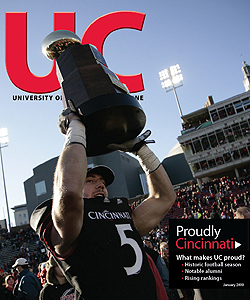by Deborah Rieselman
First steam-powered fire engine -- Alexander Latta, faculty member, College of Applied Science's predecessor school OMI, helped develop this technology in 1852.
Nation's first salaried fire company -- OMI board president Miles Greenwood organized it in 1853.
National Weather Service -- First observations leading to the National Weather Service came from Cincinnati Observatory director Cleveland Abbe in the 1860s.
First program of cooperative education -- Developed by engineering dean Herman Schneider in 1906.
First electronic organ -- Invented by student Winston Kock, Eng '32, MS (Eng) '33, HonDoc '52, as his electrical engineering undergraduate thesis.
First antihistamine, Benadryl -- Chemical engineering researcher George Rieveschl developed it in the 1940s.
Two asteroids discovered -- Asteroid "1373 Cincinnati" (discovered in 1935) is named after UC's Cincinnati Observatory, and asteroid "1751 Herget" (discovered in 1955) is named after UC professor Paul Herget, A&S '31, MA (A&S) '33, PhD (A&S) '35, HonDoc '78, who officially tracked these "minor planets" and calculated their orbits.
First heart-lung machine -- Cardiologist Samuel Kaplan, chemist Leland Clark and surgery professor James Helmsworth developed it in 1951.
First oral polio vaccine -- Developed by medical researcher Albert Sabin, HonDoc '74, in the late 1950s.
First medical laser lab -- Dermatology professor Leon Goldman, MD '29, opened the country's first such lab in 1961.
First emergency medicine residency program -- Established at the university-affiliated hospital in 1970.
First degree program offered via satellite -- In 1977.
First YAG laser -- Neurosurgery professor John Tew used it to vaporize previously inoperable brain tumors in 1984.
Related article:
Bringing medical research to reality

 Issue Archive
Issue Archive